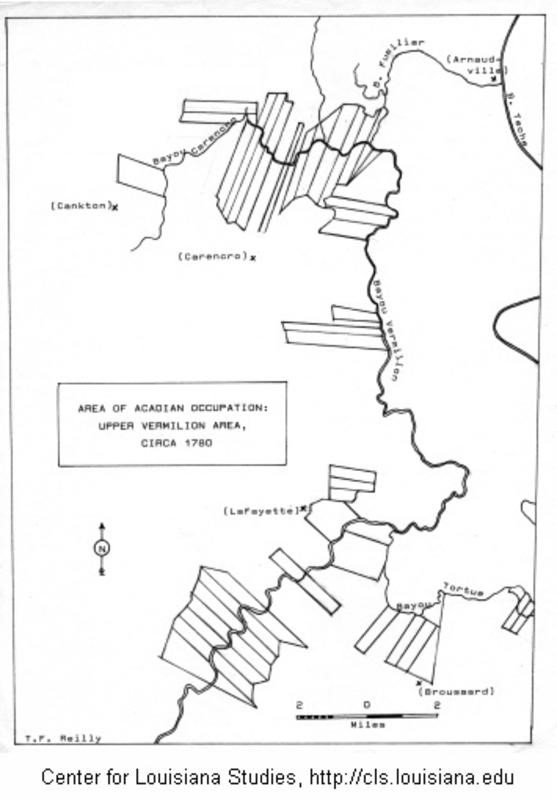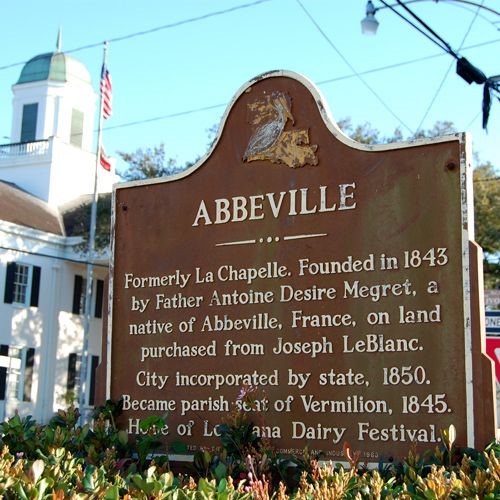Acadian colonization along the lower part of Vermilion Bayou (also called the Vermilion River) took place around the present-day municipality of Abbeville, seat of Vermilion Parish, between the Têche and Queue de Tortue bayous in southwestern Louisiana. Unfortunately, historical writings tell us very little about the twenty-five or so Acadian families who came from the north to settle there. However, we know that upon the Acadians’ arrival, the Spanish administration conditioned their settlement towards the frontiers of the Native American territories within Louisiana. As Louisiana grew, some Acadians were forced to relocate and others voluntarily followed the border change. From 1764 Acadian settlements spread north from New Orleans to undeveloped areas along the Mississippi River. Over time, this region became known as the “Acadian Coast”. Then other Acadian communities were established upstream, to later move downstream Vermilion Bayou toward the south from the bayou’s upper part. People settled in a line on both sides of the bayou, as they had done in Acadia (now Nova Scotia). Their homes were on narrow patches of land stretching from the shoreline to the marshes, as shown on the accompanying maps of Upper and Lower Vermilion circa 1780 drawn by Timothy F. Reilly.
The community chapel

Prior to the construction of a road parallel to the bayou, settlers navigated from house to house visiting each other or meeting in a place of worship. According to Acadian folklore, it is in a room reserved for Catholicism inside a private residence that masses, baptisms, weddings and other religious ceremonies were held. In fact, this private house (still unknown) served as an oratory or chapel without parish status. A historic bronze plaque near the current church reminds visitors that the location of Abbeville (founded 1843) was previously called “La Chapelle” (i.e., The Chapel).

As indicated on the accompanying historical marker, Abbeville (Louisiana) bears the same name as Abbeville (France), birthplace of Capuchin Father Antoine Désiré Mégret, founder of Abbeville (Louisiana). While Abbeville (Louisiana) was founded in 1843, the origins of Abbeville (France) date back to the Gallo-Roman period, more precisely to the years 380 AD. We know that Father Megret bought the original grounds of Abbeville (Louisiana) from a man named Joseph LeBlanc (husband of Isabelle Broussard) for the sum of $ 900 on July 25, 1843. A few weeks later, the newly acquired Joseph LeBlanc house was transformed into a community chapel. Megret’s chapel was completely burned down in 1854. Since the fire, four catholic churches dedicated to St. Mary Magdalen have successively been erected on this historic site. The actual church was built in 1911 under the direction of Father Laforest.

According to genealogy, the surname Leblanc is frequently associated with Acadians. This is a generally known fact simply because it is numerically the largest Acadian family. The place of origin in France of Daniel Leblanc, the family’s lead ancestor in America, has yet to be discovered. Some say that Daniel Leblanc is a native of Poitou or Maine or perhaps Dauphine. We know for sure, nevertheless, that he was among the first inhabitants of Acadia, having arrived in the late 1640s, at the age of about 24 years. During the Great Upheaval, many descendants of Daniel Leblanc were deported to the Anglo-American colonies before their establishment in Louisiana.
“Cadien”, anglicized “Cajun”, is in fact a pejorative distortion of the word “Acadian” which is linked to the descendants of Acadia’s exiles. Abbeville, whose municipal motto is “Pour dieu et la patrie”, displays in its own way and with pride its Cajun heritage through names given to numerous streets. The naming in its entirety commemorates the Acadian families who did live in the Louisiana city of Abbeville. They are the Bergeron, Bernard, Bertrand, Breaux, Broussard, Chauvin, Chiasson, DesChenes, Doucet, Dugas, Forest, Hebert, Lachaussee, Landry, Laporte, Leblanc, Mouton, Naud, Prejean, Primeaux, Richard, Samson, Theriot, Trahan, and Valcourt, among others.
